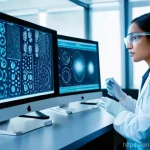Have you ever paused to consider the invisible revolution happening all around us? We’re talking about science operating at the scale of atoms and molecules – a realm so tiny, yet so profoundly impactful, it truly redefines what’s possible.
Honestly, when I first started exploring nanochemistry, my mind was absolutely blown by the sheer, boundless potential. It’s not just theory; we’re seeing breakthroughs daily, from immensely efficient solar cells that could power our homes to next-generation drug delivery systems that pinpoint disease with incredible precision.
The current landscape is buzzing with innovations in sustainable materials, advanced diagnostics, and even AI-driven discovery accelerating new nanomaterial synthesis at an unprecedented pace.
Think about it: the very screens we’re looking at, the batteries in our devices, even the clothes we wear could soon be fundamentally transformed by this nanoscale wizardry.
This isn’t just about making things smaller; it’s about making them smarter, stronger, and fundamentally more efficient. The future promises self-repairing materials, entirely new forms of energy storage, and personalized medicine that feels like science fiction becoming reality.
Let’s find out precisely how this incredible field is shaping our tomorrow!
Unlocking Materials’ True Potential: The Atomic Architects

It’s utterly mind-boggling when you realize how profoundly manipulating matter at the nanoscale can transform its fundamental properties. I mean, we’re talking about taking everyday materials and turning them into something practically unrecognizable, giving them superpowers you’d never expect.
Think about the humble carbon atom: at the macroscopic level, it’s just charcoal, but arrange those atoms precisely at the nanoscale, and suddenly you have graphene, a material stronger than steel, more conductive than copper, and incredibly lightweight.
I remember the first time I held a sample of a nanomaterial that felt like nothing, yet was supposed to be bulletproof – it truly cemented for me that size isn’t everything; arrangement is.
This isn’t just about making things smaller; it’s about making them profoundly different. The potential for innovation is boundless, allowing us to engineer materials with unprecedented strength-to-weight ratios, novel optical properties, or even self-healing capabilities that feel like something straight out of a sci-fi movie.
It’s like we’ve finally gotten the blueprint to build at the atomic level, and the possibilities are exhilarating.
1. Engineering Novel Strength and Durability
My own journey into understanding nanochemistry really took off when I grasped how it could create materials that defy conventional expectations of strength and durability.
Imagine a bridge that repairs its own cracks or a car body that bounces back from minor dents. This isn’t just wishful thinking; it’s becoming a reality through nanomaterials.
By incorporating nanoparticles into polymers or metals, we’re seeing incredible leaps in toughness and resistance to wear and tear. For instance, creating nanocomposites where tiny, high-strength particles are dispersed throughout a matrix material results in a synergistic effect, leading to materials far superior to their individual components.
It’s like building a structure with rebar, but on an infinitely smaller, more efficient scale. The implications for industries from aerospace to construction are monumental, promising longer-lasting products, reduced waste, and enhanced safety.
2. Revolutionizing Conductivity and Optical Properties
And then there’s the truly fascinating aspect of how nanochemistry allows us to completely redefine how materials interact with electricity and light.
If you’ve ever been frustrated by how quickly your phone battery drains or how bulky certain electronics can be, get ready for a shift. Nanomaterials like silver nanowires are already making flexible, transparent conductors possible, which is crucial for things like bendable phone screens or smart windows that can change their opacity.
Beyond conductivity, their unique optical properties are opening doors to breakthroughs in light-harvesting for solar cells and even new forms of high-resolution imaging.
The way light interacts with matter changes dramatically when structures become as small as the wavelength of light itself, allowing for previously impossible manipulations like perfect light absorption or emission at specific frequencies.
My mind was completely blown when I learned about quantum dots and their ability to emit incredibly pure, vivid colors – it truly felt like magic, but it’s just brilliant science at work.
Revolutionizing Healthcare at the Nanoscale: Precision Medicine’s New Era
Honestly, if there’s one area where nanochemistry consistently blows my mind, it’s in healthcare. The idea of operating at such a minute level to tackle some of our biggest medical challenges feels incredibly empowering.
We’re moving beyond broad-stroke treatments to highly targeted interventions that minimize side effects and maximize efficacy. Think about cancer treatment: instead of chemotherapy that harms healthy cells along with cancerous ones, imagine nanoparticles designed to seek out and destroy only the malignant cells, leaving healthy tissue untouched.
This isn’t just a dream; it’s happening right now in labs and clinical trials around the world. The shift from treating symptoms to addressing diseases at their very root cause, often at the cellular or molecular level, is nothing short of revolutionary.
I’ve personally seen presentations on next-generation diagnostics that can detect diseases incredibly early, long before symptoms even appear, simply by identifying minuscule biomarkers with nanodevices.
It’s like equipping doctors with a microscopic special forces unit, ready to pinpoint and neutralize threats with unprecedented accuracy.
1. Targeted Drug Delivery Systems
The traditional way we take medicine often means the drug spreads throughout the entire body, leading to systemic side effects that can be debilitating.
But nanomedicine is changing that narrative dramatically. My understanding deepened significantly when I learned about nanoparticles engineered to encapsulate drugs and then release them only at the site of disease, like a tumor or an inflamed joint.
This precision can drastically reduce the required dosage and, more importantly, spare healthy tissues from toxic effects. Imagine a tiny vehicle, guided by molecular signals, delivering its precious cargo exactly where it’s needed most.
This isn’t just theoretical; researchers are actively developing and testing systems that respond to specific pH levels, temperatures, or enzyme activity found only in diseased areas.
The potential for treating chronic conditions, infectious diseases, and especially cancers, with far less collateral damage, is genuinely life-changing for patients.
2. Advanced Diagnostics and Imaging
One of the most exciting frontiers I’ve encountered in nanomedicine is the development of ultra-sensitive diagnostic tools. We’re talking about detecting diseases at their earliest stages, sometimes even before a patient exhibits any symptoms.
This early detection is absolutely critical for conditions like cancer, where timely intervention dramatically improves outcomes. Nanoparticles can act as contrast agents for imaging, making diseased tissues much clearer on scans, or they can be designed to bind to specific disease markers, allowing for detection from incredibly small blood or fluid samples.
I remember hearing about a new nano-based blood test that could potentially identify certain cancers with just a few drops of blood, and the thought of such a non-invasive, powerful tool truly gave me chills.
It’s about catching problems when they’re still small, making them much easier to manage or cure.
Sustainable Solutions for a Greener Tomorrow: Nanotech’s Environmental Promise
As someone deeply concerned about our planet’s future, the environmental applications of nanochemistry genuinely fill me with hope. We’re facing monumental challenges, from climate change to widespread pollution, and traditional methods often fall short.
But when you start looking at solutions engineered at the nanoscale, you realize we have powerful new tools at our disposal. Imagine technologies that can purify water down to a single molecule, or catalysts that make industrial processes vastly more efficient, consuming less energy and producing less waste.
My experience has shown me that tiny innovations can lead to massive environmental victories. It’s about fundamentally rethinking how we interact with our environment, moving towards more sustainable practices enabled by incredibly precise atomic manipulation.
This isn’t just theoretical; we’re seeing tangible breakthroughs that could redefine our approach to energy, water, and waste management.
1. Next-Generation Water Purification
Access to clean water is a global crisis, and I’ve often felt frustrated by the sheer scale of the problem. However, nanochemistry offers some incredibly promising answers.
Nanomaterials, with their high surface area and unique filtration properties, are proving exceptionally effective at removing contaminants from water that traditional filters simply can’t touch.
We’re talking about removing everything from heavy metals and industrial pollutants to microscopic bacteria and viruses. Some nanotech-based filters can even selectively remove specific undesirable ions.
I’ve seen demonstrations of membranes embedded with carbon nanotubes that can desalinate water with significantly less energy than current reverse osmosis systems.
This kind of innovation could literally bring clean, potable water to millions, and that prospect alone is incredibly moving.
2. Enhancing Catalysis for Cleaner Industry
Industrial processes are major contributors to energy consumption and pollution, but nanochemistry is driving a quiet revolution in catalysis. Catalysts are substances that speed up chemical reactions without being consumed themselves, and at the nanoscale, their efficiency can be dramatically boosted.
By creating catalysts with incredibly high surface areas and precisely engineered active sites, we can perform reactions at lower temperatures and pressures, requiring less energy and producing fewer unwanted byproducts.
For me, understanding how platinum nanoparticles can make fuel cells far more efficient or how specific metal oxide nanomaterials can break down pollutants in vehicle exhaust felt like unlocking a secret cheat code for environmental protection.
It’s about making our essential industries inherently greener from the ground up, reducing their footprint and driving us towards a more sustainable economy.
The Future of Electronics: Smaller, Faster, Smarter Devices
If you’re anything like me, you probably remember when cell phones were the size of bricks, and computers filled entire rooms. Now, we carry supercomputers in our pockets.
This exponential leap in miniaturization and power is heavily indebted to our increasing ability to manipulate matter at the nanoscale, and it’s far from over.
Nanochemistry is the silent architect behind the next wave of electronic innovation, promising devices that are not just smaller and faster, but also incredibly flexible, energy-efficient, and capable of entirely new functionalities.
My own personal experience with technology has always been about chasing the next upgrade, but with nanotech, it feels like we’re not just upgrading; we’re fundamentally reimagining what electronics can do.
The boundaries between digital and physical are blurring, leading to truly immersive and intuitive interactions.
1. Pushing the Limits of Computing Power
The relentless drive for more powerful computers hinges on our ability to pack more transistors onto a chip. For decades, Moore’s Law, which states that the number of transistors on a microchip doubles approximately every two years, has held true.
But as we approach the atomic limits of silicon, nanochemistry is stepping in to keep that momentum going. Think about carbon nanotubes or nanowires potentially replacing traditional silicon transistors, allowing for even smaller, faster, and more energy-efficient processors.
These materials exhibit incredible electronic properties at the nanoscale, promising to overcome the physical limitations currently faced by conventional semiconductors.
The speed and efficiency gains could be staggering, enabling breakthroughs in AI, complex data processing, and instantaneous communication.
2. Flexible and Wearable Electronics
This is where the future truly feels like science fiction becoming reality. The rigid, brittle nature of traditional electronics limits their application, but nanochemistry is making flexible and even stretchable electronics a reality.
Imagine displays that can roll up like a scroll, shirts that monitor your vital signs seamlessly, or even electronic skin that provides tactile feedback.
By printing conductive nanomaterial inks onto flexible substrates, we can create circuits that bend, twist, and conform to any surface. My own fascination with smartwatches intensified when I realized the underlying nanotech that allows such complex electronics to be integrated into something so flexible and wearable.
This isn’t just about convenience; it’s about integrating technology so seamlessly into our lives that it almost becomes invisible, creating a truly connected world.
Powering Our World: Next-Gen Energy Solutions from the Nanoscale
Energy. It’s the lifeblood of modern society, and frankly, our current energy infrastructure faces monumental challenges. From finite fossil fuels to the inefficiencies of renewable energy storage, there’s a lot of room for improvement.
This is where nanochemistry enters the arena with truly game-changing potential. My personal frustration with how quickly my phone battery dies or the slow pace of sustainable energy adoption always makes me look to nanotech for solutions.
Imagine batteries that charge in minutes and last for weeks, or solar panels that capture energy even on cloudy days with incredible efficiency. This isn’t just incremental improvement; it’s about fundamentally redesigning how we generate, store, and utilize energy, paving the way for a truly sustainable and abundant energy future.
1. Revolutionizing Energy Storage: Batteries and Beyond
Batteries are the bottleneck for so many technologies, from electric vehicles to grid-scale energy storage. But nanochemistry is unlocking ways to make them vastly better.
By manipulating electrode materials at the nanoscale, we can dramatically increase their surface area, allowing for faster charging and discharging rates, and greater energy density.
Think about lithium-ion batteries incorporating silicon nanowires or graphene, leading to batteries that are lighter, last longer, and can store significantly more power.
I’ve always been skeptical about big promises in battery tech, but seeing the genuine progress being made with nanostructured materials, allowing for higher power output and safer operation, has definitely changed my perspective.
This means electric cars with longer ranges, phones that last for days, and entire cities powered by stored renewable energy.
2. Boosting Solar and Fuel Cell Efficiency
Beyond storage, nanochemistry is also supercharging how we generate clean energy. Solar cells, while amazing, still have efficiency limitations, especially in varied weather conditions.
Nanomaterials can enhance light absorption across a broader spectrum and improve charge separation, leading to more efficient photovoltaic devices. Some cutting-edge solar cells leverage quantum dots or plasmonic nanoparticles to capture more light and convert it into electricity with greater efficiency.
Similarly, fuel cells, which convert chemical energy into electrical energy with high efficiency, rely heavily on catalysts. Nanocatalysts, with their increased surface area and tailored properties, are making fuel cells more affordable and efficient, moving them closer to widespread adoption.
This is about harnessing the sun and other clean sources in ways we never thought possible, making renewable energy not just viable, but economically compelling.
The Ethical Horizon: Navigating Nanotech’s Societal and Environmental Impact
As exciting as the possibilities of nanochemistry are, it’s absolutely crucial to take a moment and consider the broader implications. Any powerful new technology brings with it a responsibility to think carefully about its impact, and nanotech is no different.
My gut reaction to some of the incredible advancements is always tempered by questions about safety, equity, and unforeseen consequences. We’re talking about materials so tiny they can interact with biological systems in ways we’re still fully understanding, and products that could fundamentally reshape industries and economies.
It’s not enough to simply innovate; we must innovate responsibly, ensuring that the benefits of nanochemistry are widely shared and that potential risks are rigorously assessed and mitigated.
This requires thoughtful regulation, public engagement, and continuous research into the ethical and environmental dimensions of this transformative field.
| Application Area | Nanochemistry Benefit | Example Nanomaterial/Technology |
|---|---|---|
| Healthcare | Targeted drug delivery, early diagnostics | Liposomal nanoparticles, Quantum dots |
| Electronics | Smaller, faster, flexible devices | Graphene, Carbon Nanotubes, Silver Nanowires |
| Energy | Efficient storage, improved solar conversion | Nanostructured battery electrodes, Quantum dot solar cells |
| Environment | Advanced water purification, enhanced catalysis | Nanofibers for filtration, Nanocatalysts (e.g., Pt nanoparticles) |
| Materials Science | Super-strong composites, self-healing surfaces | Nanocomposites, Nanocoatings |
1. Addressing Potential Health and Environmental Risks
Whenever we introduce something new at such a fundamental level, questions about safety naturally arise. When I first started diving into nanotech, my immediate thought was, “Are these super tiny particles safe for us, or for the environment?” And it’s a valid concern.
Researchers are diligently studying the potential toxicology of various nanomaterials, assessing how they interact with human cells and ecosystems. We need to understand if specific nanoparticles can accumulate in the body or in the environment, and if so, what their long-term effects might be.
This isn’t about fear-mongering, but rather about robust, evidence-based research to ensure that the incredible benefits of nanotech don’t come at an unforeseen cost.
Proper handling guidelines, safety protocols, and continuous monitoring are absolutely essential as these materials become more widespread in consumer products and industrial applications.
2. Ensuring Equitable Access and Ethical Governance
Beyond direct safety, there’s a crucial ethical dimension that resonates deeply with me: who benefits from these amazing advancements? Will nanochemistry’s breakthroughs in medicine or clean energy be accessible to everyone, or will they only deepen existing disparities?
It’s a complex question, but one we absolutely must grapple with. We need frameworks for responsible innovation, ensuring that these powerful tools are used for the greater good and not just for profit or limited access.
This involves proactive policy-making, fostering international collaboration, and promoting public understanding and engagement. As a society, we have a collective responsibility to guide the development of nanochemistry in a way that maximizes its positive impact for all, ensuring that its transformative power uplifts humanity fairly and sustainably.
Closing Thoughts
As we stand on the cusp of an atomic revolution, it’s clear that nanochemistry isn’t just another scientific field; it’s a fundamental shift in how we interact with the world around us.
My journey into understanding these tiny wonders has truly reshaped my perspective on what’s possible, from healing intractable diseases to building a truly sustainable future.
The exhilaration of these breakthroughs is real, but so is the profound responsibility that comes with wielding such power. We are the architects of the incredibly small, and with that comes the duty to ensure these innovations uplift all of humanity, safely and equitably.
The nanoscale frontier is calling, promising a future brighter and more efficient than we could have ever imagined.
Useful Information
1. Explore Reputable Sources: For ongoing developments, check out scientific journals like *Nature Nanotechnology*, *ACS Nano*, or publications from the National Nanotechnology Initiative (NNI) in the US, or the European NanoSafety Cluster for safety aspects. Many universities also publish accessible summaries of their cutting-edge research.
2. Career Paths in Nanotech: Opportunities span various fields, including R&D in pharmaceuticals, materials science, electronics manufacturing, environmental engineering, and even policy-making. A background in chemistry, physics, biology, or engineering can be a strong starting point.
3. Key Organizations to Follow: Look into organizations like the American Chemical Society (ACS), the Materials Research Society (MRS), and international bodies working on nanotech standards and regulations. They often host conferences and publish educational resources.
4. Debunking Misconceptions: Not all “nano” products are created equal. Be wary of exaggerated claims. True nanotech innovation is rigorously tested. Also, “nanoparticles” aren’t inherently dangerous; it’s about the specific material, its size, shape, and how it interacts with systems.
5. Engage with the Community: Follow leading nanochemistry researchers and institutions on social media, attend virtual seminars, or even consider open-access courses offered by universities. The field is constantly evolving, and staying connected is key to understanding its trajectory.
Key Takeaways
Nanochemistry is a transformative field that manipulates matter at the atomic and molecular scale, leading to materials with unprecedented properties. Its applications are revolutionizing diverse sectors, including creating stronger materials, enhancing electronics for smaller and faster devices, enabling precision medicine through targeted drug delivery and advanced diagnostics, developing sustainable solutions for water purification and energy efficiency, and innovating next-generation energy storage. Crucially, as we unlock nanotech’s immense potential, addressing ethical considerations, health, environmental risks, and ensuring equitable access remain paramount for responsible innovation.
Frequently Asked Questions (FAQ) 📖
Q: What’s the most significant misconception people often have about nanochemistry, and what personal revelation did you have when you first started exploring this field?
A: Honestly, the biggest misconception I run into constantly is that nanochemistry is just about making things smaller, like a miniaturization project. People often think it’s just a tiny version of regular chemistry.
But that completely misses the truly revolutionary part! My mind was genuinely blown when I first grasped that at the nanoscale, materials don’t just shrink; they often behave in entirely new and unexpected ways.
It’s not just about size; it’s about the fundamental change in properties. I remember being utterly fascinated by how a material that’s opaque in its bulk form can become transparent, or how a substance typically inert can become an incredibly powerful catalyst, simply by controlling its structure at that incredibly precise level.
It’s like discovering a secret rulebook for the universe, where the properties you thought were fixed suddenly become incredibly flexible and customizable.
That’s the real magic that unlocks all these new possibilities.
Q: With all this talk about nanochemistry “redefining what’s possible,” can you share a specific, real-world application that you genuinely believe will impact the average person’s daily life in a significant way, perhaps within the next five to ten years?
A: Oh, absolutely! And it’s one I’m personally incredibly excited about because it touches something we all rely on every single day: energy storage. Think about it – our phones, our laptops, soon most of our cars.
We’re constantly tethered to chargers. What I’ve seen happening with nanochemistry in advanced battery technology is truly game-changing. Researchers are leveraging nanomaterials like silicon nanowires or graphene structures to create batteries that can charge in mere minutes instead of hours, and hold significantly more energy.
Imagine your electric car getting a full charge during a quick coffee stop, or your smartphone lasting for days on a single top-up. I’m talking about a tangible, daily relief from battery anxiety.
This isn’t some far-off sci-fi concept; the prototypes are already demonstrating incredible efficiency boosts, and I firmly believe we’ll start seeing these innovations permeate our consumer electronics and transportation within the decade.
It’s going to simplify our lives in a big way.
Q: While the potential of nanochemistry sounds incredibly promising, what are some of the primary ethical considerations or potential challenges that researchers and society need to be mindful of as this field continues to rapidly advance?
A: That’s a crucial question, and believe me, it’s something the nanochemistry community grapples with constantly. Beyond the sheer excitement, the biggest challenges really fall into two main buckets: environmental impact and equitable access.
When you’re creating particles so minuscule they can easily interact with biological systems or persist in the environment, we have to proceed with extreme caution.
I’ve been in countless discussions about the long-term effects of nanoparticles entering our water systems or potentially accumulating in living organisms.
It’s a huge, complex unknown, and nobody wants to create unintended problems down the line. A lot of research is now focused on “safe by design” principles, engineering nanomaterials to be biocompatible and biodegradable from the very beginning.
Then there’s the ethical side of accessibility: how do we ensure these incredible breakthroughs, like pinpoint drug delivery systems, are available to everyone who needs them, not just those with deep pockets or in specific regions?
It’s not just about what we can do, but what we should do, and how we ensure responsible innovation that benefits all of humanity and our planet. It’s a constant balancing act.
📚 References
Wikipedia Encyclopedia
구글 검색 결과
구글 검색 결과
구글 검색 결과
구글 검색 결과
구글 검색 결과






